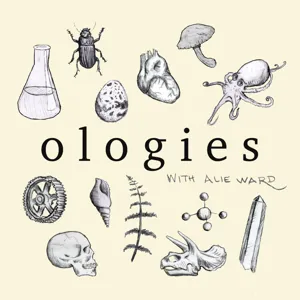Podcast Summary
Exploring Community, Personal Growth, and Discovery: Building strong community connections is vital for personal growth and preparedness. Listen to podcasts, engage in conversations, and explore new things to learn and grow.
Building strong community connections is essential for personal growth and preparedness, as highlighted by Neighbor to Neighbor, a California volunteer network. Meanwhile, through conversations on his podcast, Conversations with UNK, comedian LeDuvall offers words of encouragement and life advice. In a different realm, the Stuff From the Science Lab podcast team, Alison and Robert, share their fascination with prehistoric animals, particularly sea monsters, as seen in Alison's childhood encyclopedia. These diverse examples emphasize the importance of community, personal growth, and the joy of learning and discovery. To connect and grow, visit caneighbors.com, listen to Conversations with UNK every Tuesday, or explore the wonders of prehistoric creatures in the Macmillan Illustrated Encyclopedia of Dinosaurs and Prehistoric Animals.
Illustrations of Ancient Marine Life with Distinct Personalities: Colin Newman's illustrations of fish and amphibians bring unique personalities to ancient marine life. Great whites and blue whales are current ocean rulers, while Megalodon, a massive ancient creature, is a favorite among enthusiasts.
While various illustrators contributed to the depiction of ancient marine life, Colin Newman's illustrations of fish and amphibians stand out for imbuing each creature with distinct personalities. The ocean's current rulers include the great white shark, which has existed for millions of years, and the blue whale, the largest known species, measuring up to 100 feet in length and weighing up to 150 tons. A notable ancient marine creature is the Megalodon, or "big tooth," which is a favorite among enthusiasts due to its massive size and the existence of popular literature about it. The Megalodon lived in isolated deep-ocean areas, leading to unique species evolution.
Discovering the 41-foot Shonosaurus in Nevada: The Shonosaurus, a 41-foot prehistoric marine reptile discovered in Nevada, is the state fossil and the largest known Ichthyosauria species, much larger than today's great white sharks.
The discussion revolved around prehistoric marine creatures, specifically the Shonosaurus, which was discovered in the 1920s and later became the Nevada state fossil. This marine reptile, also known as a fish lizard due to its order Ichthyosauria, was approximately 40.9 feet long, making it much larger than the largest great white shark. The Shonosaurus had a potbelly and a sharper beak with teeth only at the front, and it was discovered in what is now present-day Nevada during the Triassic period when the area was underwater. The discussion also touched upon the fascination with prehistoric sea monsters and their imagined battles among fans on the internet.
Discovering Unique Marine Reptile Characteristics: Shonosaurus' Live Birth and Leapluridon's Fearsome Appearance: The Shonosaurus, a live-birthing ichthyosaur, and the Leapluridon, a powerful plesiosaur with a fearsome appearance, highlight the diverse and successful marine reptile population during the Mesozoic Era.
The ichthyosaurians, specifically the Shonosaurus and the Leapluridon, were highly successful marine reptiles with unique characteristics. The Shonosaurus, a member of the ichthyosaur order, gave birth to live young at sea, unlike other species that laid eggs on land. This was discovered through a fossil of an adult female giving birth. The ichthyosaurians thrived for around one billion years before going extinct, despite occupying the ecological niche of modern-day dolphins. Moving on to the plesiosaur order, the Leapluridon stood out with its fearsome appearance. This creature was streamlined, with a cruel-looking head, thick neck, and massive flippers. Paleontologists believe it was extremely maneuverable and an excellent long-distance swimmer. The Leapluridon likely hunted its prey through long pursuits, wearing them down over time, much like early human hunters. Its powerful jaws and teeth allowed it to take down almost anything it wanted, making it a top predator. Both the Shonosaurus and the Leapluridon showcase the diversity and success of marine reptiles during the Mesozoic Era.
Understanding the Food Chain Pyramid and Size Estimations of Extinct Creatures: Though top predators play a crucial role in ecosystems, they represent a small portion of the overall biomass due to the vast number of herbivores and plant life at the bottom of the food chain.
The food chain, represented as a pyramid, consists of various animal species with those at the top, such as predators, having fewer numbers compared to the vast amount of plant life and herbivores at the bottom. For instance, the extinct Leoporidon, a late Jurassic creature, was estimated to be around 39 feet long, but some exaggerated claims suggested it could reach up to 82 feet. The lack of fossil records and the desire for funding and media attention can contribute to such size estimations. The top predators, despite their significance, make up a small portion of the overall biomass. This is an intriguing aspect when studying fossil records.
From largest to smallest prehistoric animals: Focusing on size alone can limit our understanding of prehistoric animals. Considering their unique adaptations provides a more complete picture of their role in the ecosystem.
Our fascination with prehistoric animals, whether land or sea creatures, often starts with their size and perceived ferocity. This was evident in our discussion about the process of selecting animals for a podcast, where we initially focused on the largest and most intimidating species. However, as we delve deeper into their unique adaptations, we may eventually develop a greater appreciation for smaller predators. This trend mirrors the shift in focus from T-Rex to velociraptors in the study of land dinosaurs. For instance, the Kronosaurus, a plesiosaur from the early Cretaceous period, is a 42-foot marine reptile that captivates us with its impressive size. Despite its formidable features, including a flat top head and strong jaws, its large head and the need to leave the water to lay eggs make it vulnerable. This underscores the importance of considering the full context of an animal's biology to understand its role in the ecosystem.
Discover dinosaurs at Kronosaurus Corner in Australia: Visit Kronosaurus Corner in Australia to discover dinosaur fossils and learn about unique prehistoric creatures like the elasmosaurus with its long neck, giving it an advantage in hunting.
The Kronosaurus Corner in Richmond, Queensland, Australia, is a must-visit for dinosaur enthusiasts. It's part of Australia's dinosaur trail and offers the opportunity to discover fossils yourself. The museum features a giant, fake Kronosaurus outside, and if you're lucky, you might even find a real dinosaur bone. The elasmosaurus, another fascinating prehistoric creature, is known for its exceptionally long neck, containing over 28 vertebrae and making up more than half of its total length. This feature likely played a role in hunting, allowing the elasmosaurus to sneak its head around corners before revealing the rest of its body to prey. While it may sound cartoonish, this ability could have given the elasmosaurus a significant advantage in the ancient world. So, if you're interested in dinosaurs and their unique adaptations, consider exploring the Kronosaurus Corner and learning more about these incredible creatures.
The Elasmosaurus may have used its long neck to spot fish from above: The Elasmosaurus, a prehistoric sea monster, potentially used its long neck for observation, contributing to its hunting strategy.
The Elasmosaurus, a prehistoric sea monster, may have used its long neck to look down at the water from above, similar to a crow's nest on a ship, in order to spot fish before striking with its head and neck to catch them. Another interesting fact about the Elasmosaurus is its role in the Bone Wars, a period during the Old West when paleontologists competed fiercely to discover and claim fossils. Two notable figures, Othniel Marsh and Edward Drinker Cope, engaged in a bitter feud over fossil discoveries, resorting to bribery, theft, and sabotage to outdo each other. Cope discovered an Elasmosaurus fossil in Kansas and worked to piece it together, adding to the scientific understanding of this fascinating prehistoric creature.
The Bone Wars: A Rivalry of Scientific Discoveries and Mistakes: The Bone Wars between Cope and Marsh show that scientific discoveries can lead to controversy, mistakes, and competition, but pushing boundaries is crucial for advancements in knowledge.
Throughout history, scientific discoveries have been met with controversy and competition. The Bone Wars between Edward Drinker Cope and Othniel Charles Marsh in the late 1800s is a prime example. Cope made a mistake in assembling a fossil, attaching the head to the tail of a dinosaur, leading to embarrassment and costly retractions. Marsh, his rival, used this opportunity to taunt Cope, despite making a similar error himself later. More recently, the discovery of Predator x, a potential 50-ton plesiosaur, has left scientists debating its classification and true nature. Predator x, with its massive size and long teeth, could potentially rewrite the history of marine reptiles. Despite the uncertainty, these discoveries show the importance of pushing boundaries in scientific exploration, even if it means making mistakes along the way. For more fascinating insights into the world of science, tune in to our podcast or visit us on social media. If you have any questions or comments, feel free to email us at scienestuff@howstuffworks.com.
Exploring advanced civilizations through Kardashev scales in science fiction: Science fiction expands our imagination of advanced civilizations by applying the Kardashev scales, which classify civilizations based on their energy usage. Examples include civilizations abiding by rules to avoid interfering with underdeveloped life, creating another universe for energy, and actively trying to collapse and reengineer the universe.
The concept of Kardashev scales, which classifies civilizations based on their energy usage, has inspired imaginative examples of advanced civilizations in science fiction. Marcus pointed out an instance from the Star Ocean RPG video game franchise, where a civilization recently achieving Type 2 (planetary energy) discovers intelligent life and abides by rules to avoid interfering with underdeveloped civilizations. Moe suggested the idea of creating another universe to generate power as a theoretical solution for energy problems, potentially making it a Type 4 (beyond galactic energy) civilization. Gary mentioned the Heechee race from Frederick Pohl's novels, who were actively trying to collapse and reengineer the universe, and the Stargate universe as examples of Type 4 civilizations. Overall, these examples expand our understanding of the possibilities of technological advancement and energy usage in the context of Kardashev scales.
Simplifying Daily Tasks with Innovative Technology: Parents can easily prepare bottles with Baby Brezza, people with diabetes can monitor their condition with Dexcom, and families can enjoy weekend adventures with the Hyundai Santa Fe
Modern technology is making everyday tasks easier and more convenient. Baby Brezza's Formula Pro Advanced offers a stress-free solution for parents by automatically preparing warm, perfectly mixed bottles at the push of a button. Meanwhile, the Dexcom G7 helps people with diabetes better manage their condition by sending glucose numbers to their phones or watches, eliminating the need for painful finger sticks. Lastly, the Hyundai Santa Fe provides a spacious and capable vehicle for families to embark on weekend adventures. These innovations demonstrate how technology can simplify and enhance our daily experiences. For parents, managing feeding becomes a breeze with Baby Brezza. People with diabetes can take more control of their condition with Dexcom. And families can conquer weekends in the all-new Hyundai Santa Fe. To learn more about these products, visit babybrezza.com, dexcom.com, or hyundaiusa.com.




